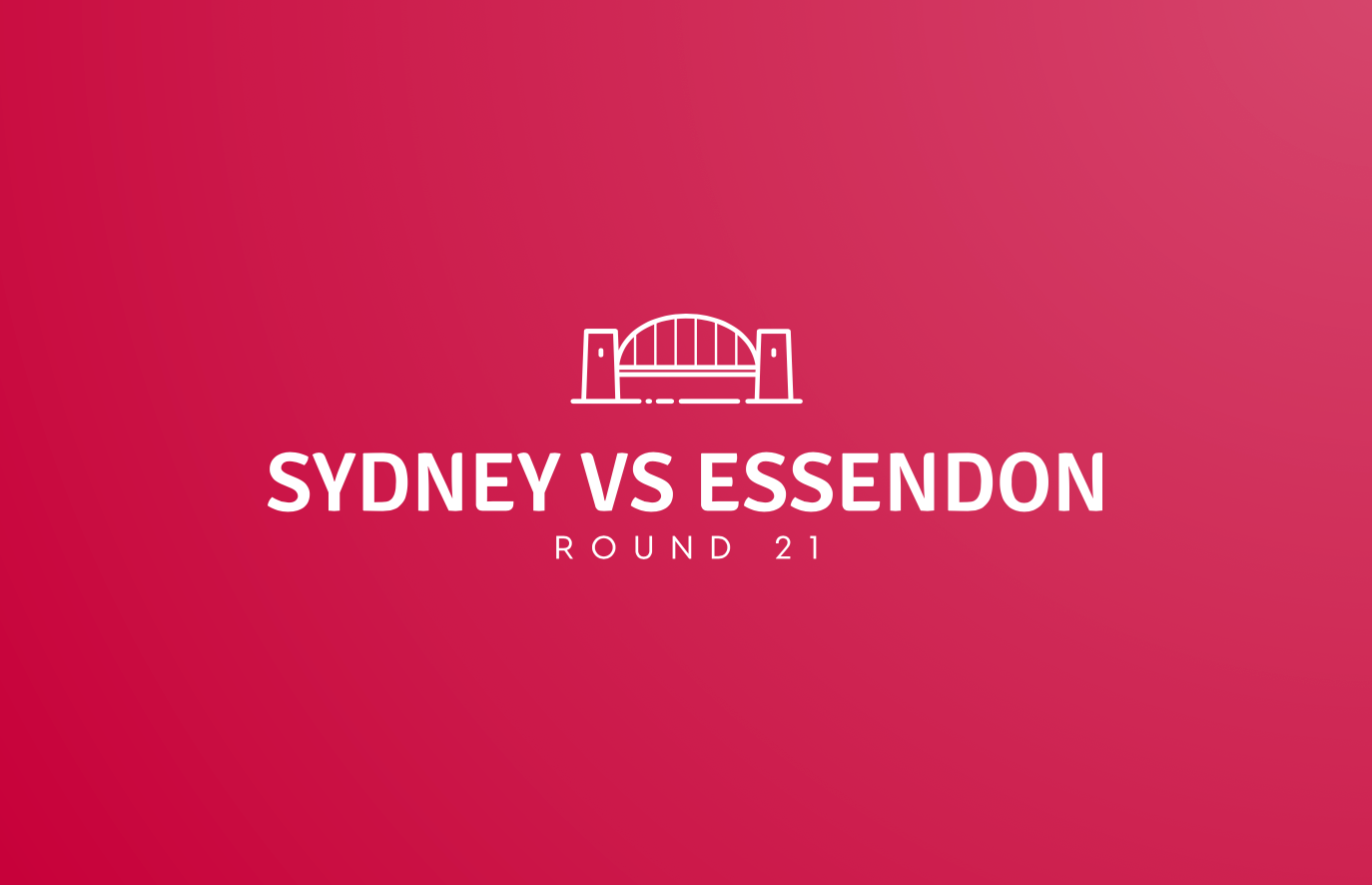
Swans vs Bombers Preview
- thebombersblog

- Jul 30
- 8 min read
It’s been a while now.
Essendon will be looking to break an eight-game losing streak against Sydney this week, facing a Swans side sure to be chasing some form of revenge after their Round 9 loss.
This trip might come at the right time for a young and inexperienced Bombers lineup, a chance to get away together, build connection, and form a tighter bond across the weekend, in what has undoubtedly been a difficult stretch for the group.
Saturday, May 10th.
Up until half time, the “control over chaos” game that has been Essendon’s default for years was at its best, with a +81 uncontested possession differential, their biggest in any half this year, aided by an 18–14 clearance edge that helped dictate the early tempo.
But more importantly, when Sydney did get their hands on the ball, Essendon’s intercept game, the version fans have long hoped to see, was at its best, winning it back every 4.38 possessions, their best rate for any half to that point of the season. That helped in two ways, denying Sydney their usual scoring power (just 16 points in a half of football), and fuelling the most important score source, with seven of Essendon’s 10 first-half shots on goal coming from intercept.
But there was never any chance Sydney were going to allow Essendon another 184uncontested possessions in the second half, with the game going to “close down” — both literally and figuratively — after the break.
The Swans won the overall clearance count 17–14 (including 16–9 at stoppages outside centre bounce), with nine of their 15 second-half shots coming via clearance. But it was their ability to shut down Essendon’s ball use going forward, ramped up by their front-half pressure, especially in the last quarter, that gave them repeat scoring options and forced Essendon to stand up under the “chaos over control.”
Saturday, August 2nd.
Gee, some of the KPIs that worked in Round 9, especially before half time, would be welcome again this week, starting at stoppages.
It’s been an inconsistent part of Essendon’s game for much of the season, and over the last seven weeks, it’s become increasingly difficult just to get the ball moving in the right direction at restarts.
Need to find some form again.
Since the standout showing against Brisbane in Round 12, a +6 clearance differential against the fifth-ranked clearance side, following a +22 performance against Richmond the week before, the Bombers are -33 in total clearances.
Having only won the count twice in that stretch.
In that Round 12 game, they outscored last year’s premiers by 33 points from stoppages, after a +22 margin from the same source the week before. But things have changed dramatically since.
Starting with the following week against Carlton through to the Bulldogs game last round, Essendon has been outscored by almost four goals per game from stoppage. Averaging
just 5.2 shots from 31.8 clearances, a strike rate of 16.3%, the lowest in the competition over that time.
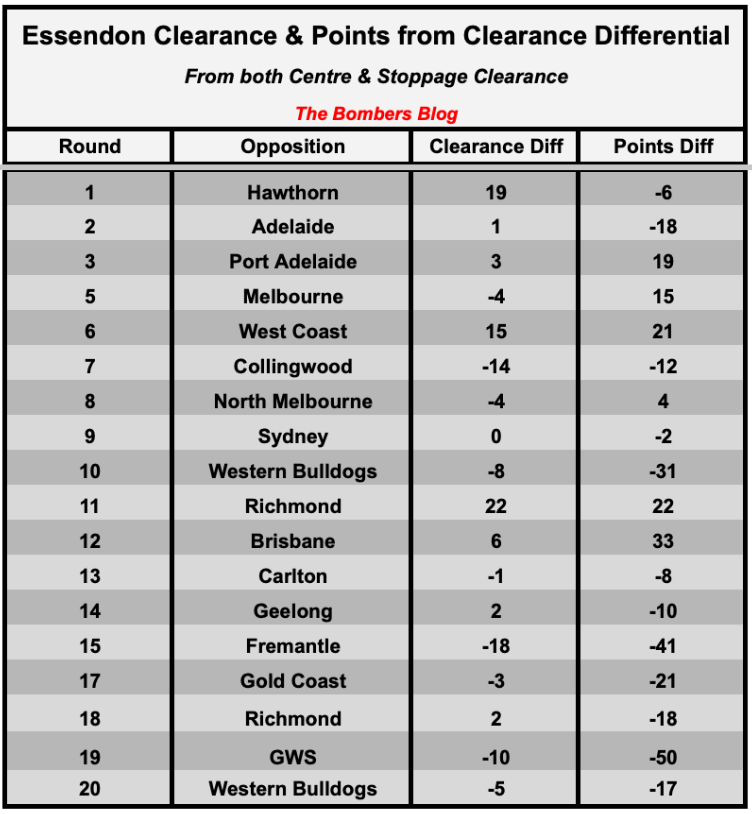
Limited midfield rotation options haven’t helped, but there are more than just the four from last week — McGrath, Shiel, Merrett, and Durham — who should want the chance to prove, even in short bursts, that they can offer something at stoppage and relieve the burden on the first-choice mix.
It’s a complete contrast to Sydney.
They found form.
Since Round 16, they’ve been the number one team in the competition for stoppage differential (+6.8), and it’s become their most damaging score source, averaging almost 47 of their 84.8 points per game from this area.
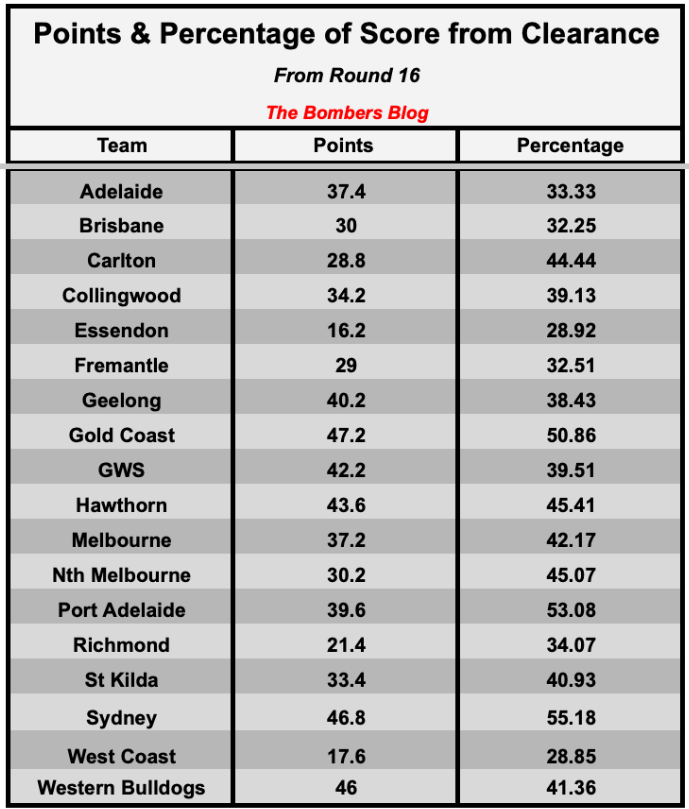
Over the last five games, Brodie Grundy has been central to that. Only Matt Rowell and Tom Green have averaged more clearances, with Grundy ranking more than 30 spots higher than the next-best ruck in this period.
No ruck to have played all five games in that stretch has grabbed the ball from a ball-up or throw-in more than Grundy, whose aim is to gain quick territory forward and put the opposition defence on the back foot, forcing them to scramble.
It’s not just on Goldstein and Wright to be ready for this tactic, those behind the ball also need to be switched on with their positioning against their matchup, and alert to react to the “dirty ball” coming their way.
Underneath Sydney’s number one ruck is Heeney, with the pair forming the Swans’ most prolific combination at stoppage and for scores from stoppage.
Much of the scoreboard damage comes from forward 50 throw-ins, meaning Essendon’s midfielders and defenders need to be alert, first with clear communication on matchups, and then with structure in what are often tight, congested spaces.
Gained a lot, lost a lot.
The reason Sydney are so reliant on scoring from stoppage is because their ability to punish from turnover has largely deserted them.
Last year, they averaged 55.1 points per game from opposition turnovers, the most of any team. That figure has dropped to just 41.9 in 2025, with a 15-point swing in the differential between themselves and their opponents.
There are a few reasons behind this shift. One is how often they’re able to disrupt the opposition. The other is their change in ball movement, a necessary adjustment to protect against their defensive vulnerabilities, particularly their one-on-one defence and issues inside defensive 50.
In their defensive half, Sydney lose almost one in every three one-on-one aerial contests, the fifth most in the competition this year. And once the ball hits the ground inside their back third, the problems continue, with opposition sides winning the third most ground balls in that zone. Only GWS and Port Adelaide give up more, but the Swans lose more per entry than both.
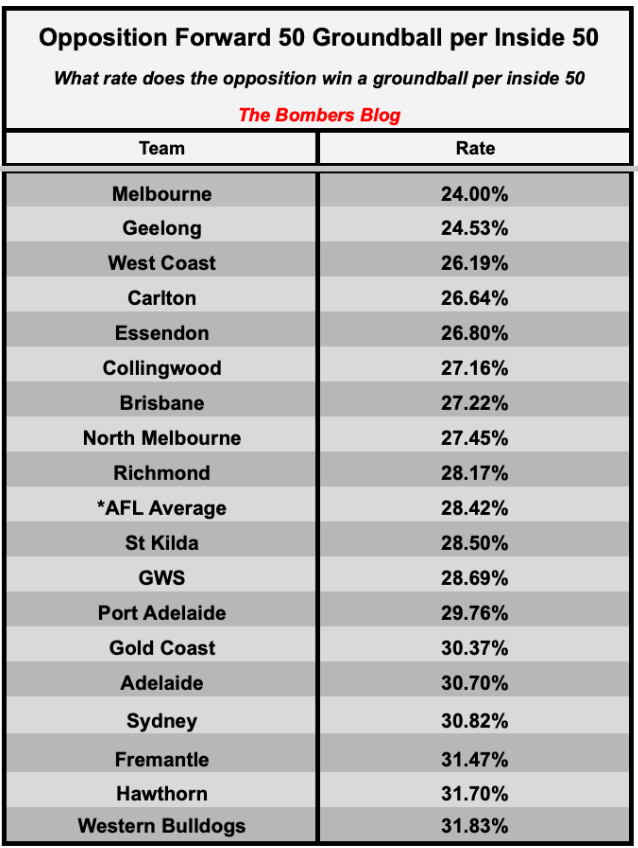
That’s led to a slower, more controlled kick-mark style with the ball to limit the damage going back the other way. But it’s also made them less threatening when trying to hurt on the scoreboard.
For Essendon to take advantage, there’s plenty of work to do across multiple areas, the first, without the footy.
Make it difficult.
One of the biggest causes of Essendon’s performances on field has been their ability, or more accurately, inability, to defend uncontested marks. There’s a whole host of flow-on effects from that, most obviously defending ball movement. If Sydney are allowed to play their preferred method, this will be another long 80 minutes for Bomber fans.
Since their 90-point debacle against Adelaide in Round 12 up until their loss last week to GWS, Sydney had averaged 93.3 uncontested marks per game as they worked their way forward to set up scoring opportunities, a big jump from their average of 76 prior to the Crows loss. That change helped their win-loss record from four wins in ten to five from seven.
While it took longer than the Giants would’ve liked, their number one priority without the football was clear: deny the Swans their luxury. Holding Sydney to just 66 uncontested marks for the night limited their efficiency in moving the ball end to end, their second-lowest since the loss to Adelaide.

Being much harder to play against, by not allowing “easy ball,” will give Essendon more chances to create contests, which has been the midfield’s biggest strength. But to truly punish Sydney this week, the next area needing work is ahead.
Time to shine.
Despite averaging the 10th most one-on-ones in the front half, more than four current top eight teams in GWS, Hawthorn, Brisbane and Collingwood, Essendon win the least of them, with the young forward line needing to stand up more consistently. That plays a part in why they average just 47.4 inside 50s a game, with only West Coast, North Melbourne and Richmond entering less. Such numbers won’t put enough sustained pressure on Sydney’s last line, force them to start possession chains further from goal, or slow them down regularly enough on the way forward.
Deeper entries would help. But to get them, Essendon need to find more uncontested marks on the way forward, something that’s been missing due to the high handball game that’s taken over.
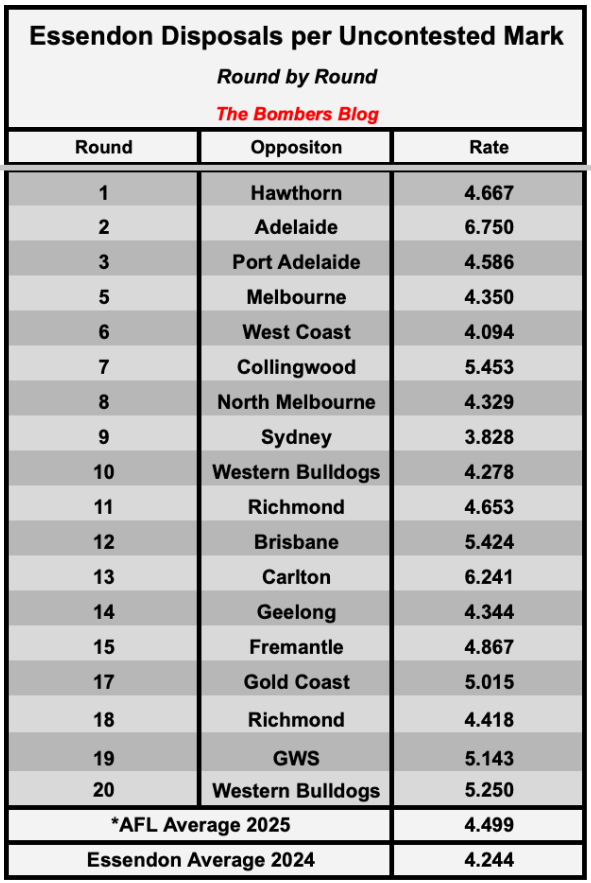
Reel it in more.
I’ve covered the shift in ball movement plenty in recent previews and reviews, but it went to a phenomenal extent last time out against the Bulldogs: https://thebombersblog.wixsite.com/thebombersblog/post/bombers-vs-bulldogs-review
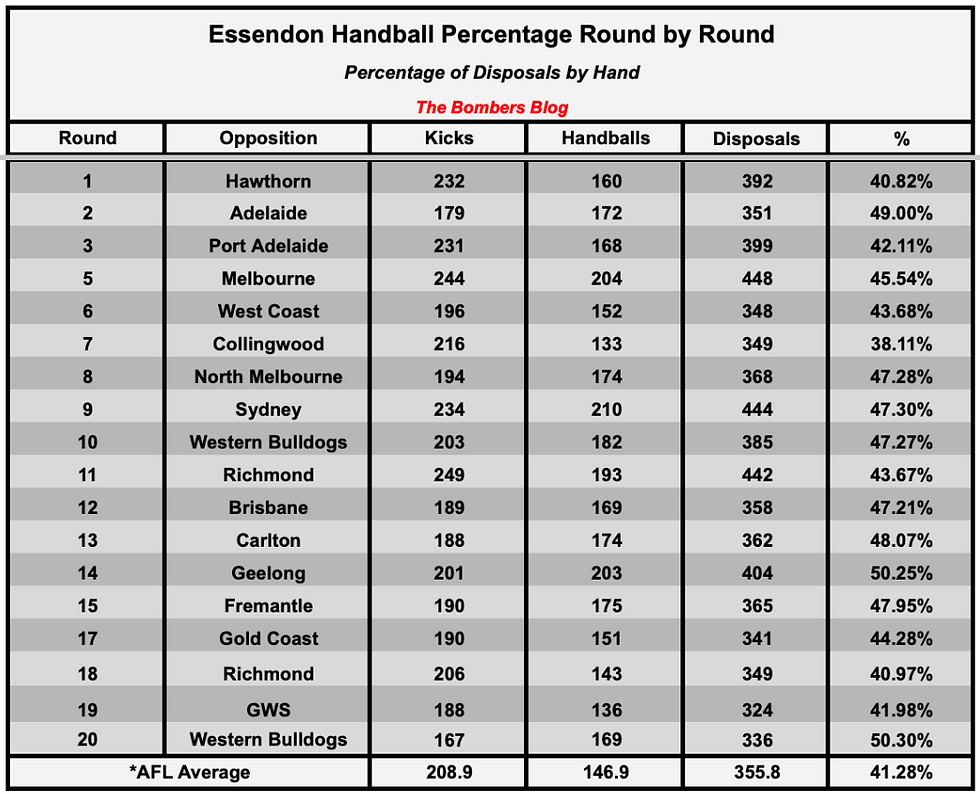
If Essendon wants a better balance between offence and defence, the change has to come not just in method but, importantly, in work rate.
Players need to get on the move much more regularly and get to realistic positions to make themselves available as short marking options, and ball users must lower their eyes and honour that effort.
That will help get the ball closer to goal, while making it much harder for it to bounce straight back out and stop it from rebounding too easily.
Forward thinking.
With five games to go and the season effectively over weeks ago now, this stretch
becomes about opportunity, not just in minutes, but in the quality of experience.
So I thought I’d take another go at identifying a few matchups that, while unlikely to eventuate,
could and should fast-track the learning curve for some of Essendon’s younger players into roles against those who’ve already mastered them.
That kind of exposure can’t be replicated at training. And for the youngsters that are largely contracted through 2026 and beyond, there’s real value in those lessons starting here and now.
It’s about positioning, timing and body work, things that can only be taught pre and post game during the week to a certain point, with the rest coming from exposure on the job, with the end goal fast tracking in anyway possible, the development of a list currently in desperate need.
Last week I would’ve assigned Angus Clarke the job of shadowing Bailey Dale, as I see Clarke in the future replicating that same line-breaking rebound and ability to launch scores from the back half. This week, it’s Nick Blakey I want him to take notes on.
Going into last week’s game, Dale was the number one defender for starting scoring chains — Blakey is number six in that category. And if I’m on the right track in thinking Clarke can run, take territory, and attack the opposition when he gets to his prime, then an early start would come through the influence of Blakey, while also playing a supporting role in trying to nullify the Swans’ number one metres gained player.
My second request is a big job, and, in the end, unrealistic to think running around with Errol Gulden for four quarters is within reach. Maybe the first half, while there’s still energy in the legs.
But I believe Archie Roberts is the one who can benefit most from Gulden’s running patterns and learn how to get into spots that are likely to receive in transition.
Gulden has the smarts and initiative to impact where the ball is, or where it’s likely to be, and there’s a long list of Essendon players, in my view, who aren’t switched on enough in thinking this way. So if a second-year draftee can start forming good habits off Sydney’s top-ranked player for uncontested possessions and handball receives, that’s a positive.
Short sharp notes.
Essendon averages 170 handballs a game, the most of any team in 2025. In fact, it’s the fourth-most by any team in a season since 2019.
Sydney are the number one team for running bounces this year, with Nick Blakey ranked sixth of all defenders and Chad Warner third of all midfielders.
Essendon averages just 13.4 intercept marks per game, with Sydney at 13.5, the fourth and fifth-fewest in the league.
Up until this round, Essendon has used 42 players, the most of any side. Sydney has selected only 34, the equal fourth-least, with only Geelong, Brisbane and Adelaide selecting fewer.
Final words.
One day, a man was walking along the beach when he noticed a boy picking something up and gently throwing it into the ocean. Approaching the boy, he asked,
“What are you doing?”
The boy replied,
“Throwing starfish back into the ocean. The tide is going out, and if I don’t throw them back, they’ll die.”
The man laughed and said,
“There must be thousands of starfish on this beach. You can’t possibly make a difference.”
The boy listened politely, then bent down, picked up another starfish, and threw it back into the sea.
“It made a difference to that one,” he said.
Go Bombers!






Comments